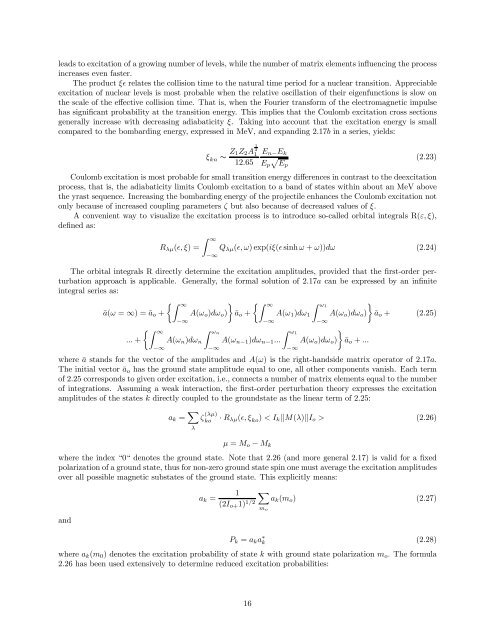coulomb excitation data analysis codes; gosia 2007 - Physics and ...
coulomb excitation data analysis codes; gosia 2007 - Physics and ...
coulomb excitation data analysis codes; gosia 2007 - Physics and ...
You also want an ePaper? Increase the reach of your titles
YUMPU automatically turns print PDFs into web optimized ePapers that Google loves.
leads to <strong>excitation</strong> of a growing number of levels, while the number of matrix elements influencing the processincreases even faster.The product ξ relates the collision time to the natural time period for a nuclear transition. Appreciable<strong>excitation</strong> of nuclear levels is most probable when the relative oscillation of their eigenfunctions is slow onthe scale of the effective collision time. That is, when the Fourier transform of the electromagnetic impulsehas significant probability at the transition energy. This implies that the Coulomb <strong>excitation</strong> cross sectionsgenerally increase with decreasing adiabaticity ξ. Taking into account that the <strong>excitation</strong> energy is smallcompared to the bombarding energy, expressed in MeV, <strong>and</strong> exp<strong>and</strong>ing 2.17b in a series, yields:ξ kn ∼ Z 1Z 2 A 1 2112.65E n− E kE ppEp(2.23)Coulomb <strong>excitation</strong> is most probable for small transition energy differences in contrast to the de<strong>excitation</strong>process, that is, the adiabaticity limits Coulomb <strong>excitation</strong> to a b<strong>and</strong> of states within about an MeV abovethe yrast sequence. Increasing the bombarding energy of the projectile enhances the Coulomb <strong>excitation</strong> notonly because of increased coupling parameters ζ but also because of decreased values of ξ.A convenient way to visualize the <strong>excitation</strong> process is to introduce so-called orbital integrals R(ε, ξ),defined as:R λμ (, ξ) =Z ∞−∞Q λμ (, ω)exp(iξ( sinh ω + ω))dω (2.24)The orbital integrals R directly determine the <strong>excitation</strong> amplitudes, provided that the first-order perturbationapproach is applicable. Generally, the formal solution of 2.17a can be expressed by an infiniteintegral series as:½Z ∞ā(ω = ∞) =ā o +A(ω o )dω o )−∞½Z ∞ Z ωn... + A(ω n )dω n A(ω n−1 )dω n−1 ...−∞−∞¾½Z ∞ Z ω1¾ā o + A(ω 1 )dω 1 A(ω o )dω o ) ā o + (2.25)−∞−∞¾Z ω1−∞A(ω o )dω o )ā o + ...where ā st<strong>and</strong>s for the vector of the amplitudes <strong>and</strong> A(ω) is the right-h<strong>and</strong>side matrix operator of 2.17a.The initial vector ā o has the ground state amplitude equal to one, all other components vanish. Each termof 2.25 corresponds to given order <strong>excitation</strong>, i.e., connects a number of matrix elements equal to the numberof integrations. Assuming a weak interaction, the first-order perturbation theory expresses the <strong>excitation</strong>amplitudes of the states k directly coupled to the groundstate as the linear term of 2.25:a k = X λζ (λμ)ko· R λμ (, ξ ko ) (2.26)μ = M o − M kwhere the index “0“ denotes the ground state. Note that 2.26 (<strong>and</strong> more general 2.17) is valid for a fixedpolarization of a ground state, thus for non-zero ground state spin one must average the <strong>excitation</strong> amplitudesover all possible magnetic substates of the ground state. This explicitly means:1 Xa k =a(2I o+ 1) 1/2 k (m o ) (2.27)m o<strong>and</strong>P k = a k a ∗ k (2.28)where a k (m 0 ) denotes the <strong>excitation</strong> probability of state k with ground state polarization m o . The formula2.26 has been used extensively to determine reduced <strong>excitation</strong> probabilities:16
















